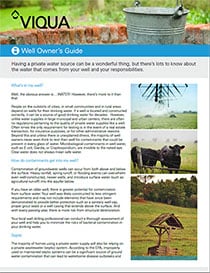
Well Water Contamination
VIQUA Well Owner’s Guide
Having a private water source can be a wonderful thing, but there’s lots to know about the water that comes from your well and your responsibilities. As such, we’ve developed this handy 4-page guide which covers off such topics as:
- Contaminants in your well
- Water Testing 101
- Water Treatment Systems for Wells
>>Click to download the VIQUA Well Owner’s Guide
If you’re using a private well or one shared with a few neighbors, you’re responsible for the quality of the water you and your family are consuming. Understanding how your well water may become contaminated with natural or man-made contaminants is key to avoiding possible illness and managing aesthetic water issues. There are multiple ways that well water contamination can happen like: heavy rainfall, spring runoff and flood events can overwhelm even well-constructed, recently drilled wells and can introduce surface contaminants into the aquifer below. If your well is older, there are even more potential avenues for surface contamination to enter your drinking water.
Well water contamination sources
Potential Well Water Contamination Issues:
- A dug well, lined with poorly sealed brick, stone, or tile, or having unsealed covers.
- An improperly sealed casing through a bedrock formation or other unconsolidated formation, which can allow the migration of contaminated water into the aquifer.
- If the well casing does not extend far enough above the ground surface, surface water can enter the top of the well casing.
- If a well casing ends in a basement, pit, or another area prone to flooding or seepage.
- Corrosion can deteriorate old well casings and allow water to seep into the well from holes or cracks.
- Contaminated near-surface water can enter a well if the well casing is at a non-complying depth.
- Old stove-pipe casings are now considered sub-standard, as they can allow near-surface water to infiltrate the well.
- The well cap could be poorly installed, allowing insects and small animals to enter the well.
- The source of the contamination is too close to the well (such as septic), and the casing does not extend deep enough to ensure bacteria have been filtered out of the water that recharges the aquifer.
Possible Microbes in Your Well
There are many types of bacteria that can live in wells, but the vast majority of them are harmless and do not cause any kind of illness. There are a few that you should be watchful for, and none of them can be detected without performing a water test. Giardia and Cryptosporidium are most commonly found in surface waters such as lakes, streams, and rivers. They can be found in wells when events such as floods and heavy rainfalls sweep surface water into open well caps, abandoned wells, or inadequately built or maintained wells. Once these microbes are in your well, they can thrive there for long periods (even in cold temperature water) unless they are removed with some form of disinfection. Cysts can also infiltrate wells and aquifers when carried along with fecal matter from sewage or animal droppings.
More than 20 percent of private domestic wells sampled nationwide contain at least one contaminant at levels of potential health concern, according to a study by the U.S. Geological Survey (USGS). Bacteria, including total coliform bacteria and Escherichia coli, were found in as many as one third of a subset of 400 wells. – United States Geological Survey
E.Coli, or Escherichia Coli, is a type of coliform bacteria. Coliforms are bacteria that are found in the intestines of warm-blooded animals like dogs, cows, and people. Not all coliforms are dangerous. Many are actually harmless. But the ones that are bad tend to be very bad. One particular strain, E.Coli 0157:H7 is a rare strain of the bacteria that is EXTREMELY toxic. Even a positive E.coli test does not mean that this particular strain is present, but it’s never worth the risk. Any indication of total coliforms on a water test result means the potential presence of E.coli and is a very good indicator that your well water has been contaminated with some type of fecal waste. There are many ways this can happen, and many are beyond your control.
Further Help and Resources
- If you suspect any of these issues with your well, it is best to call in professional help. Get in touch with your local well drilling professional.
- To learn more about how to take care of your well, and how to identify potential issues, the National Ground Water Association has a fantastic resource, wellowner.org. This website covers all the basic information pertaining to well ownership and stewardship and runs regular training classes about well care.
